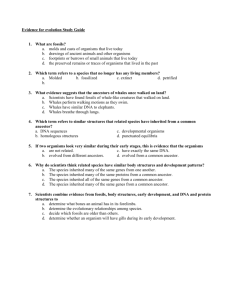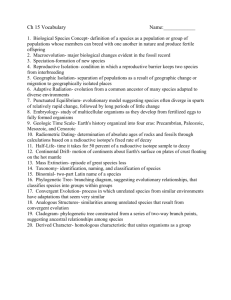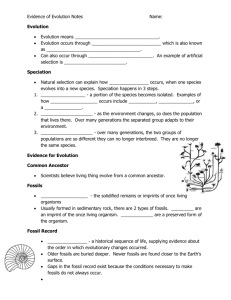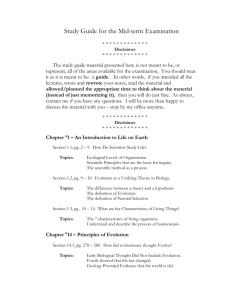Heridity and evolution
advertisement
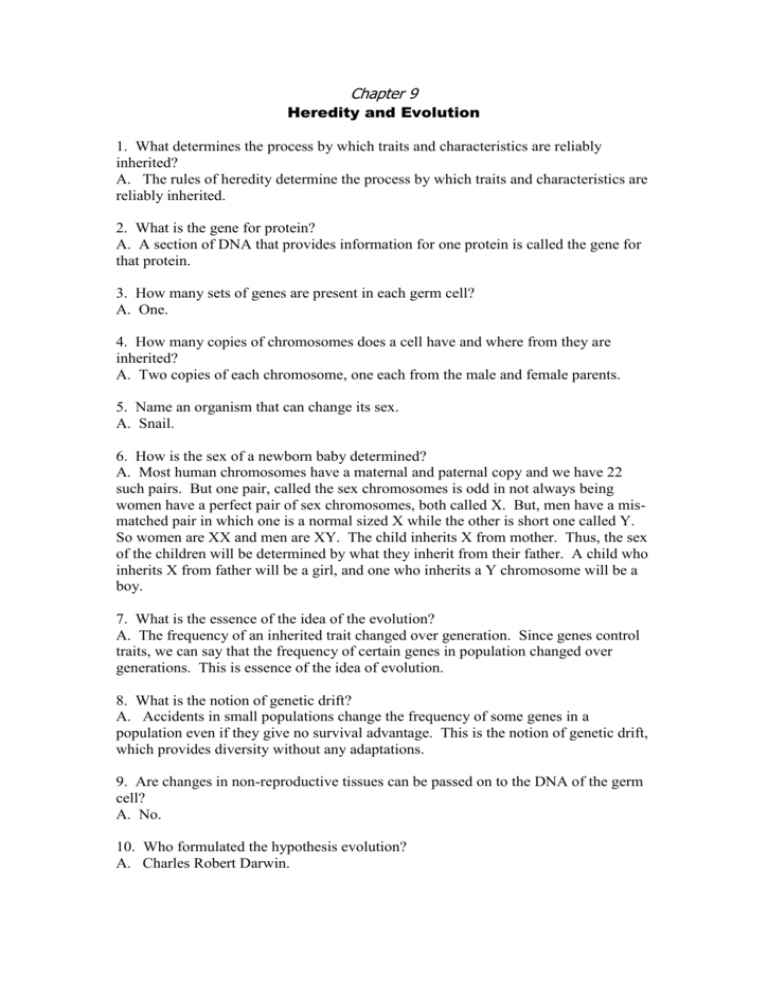
Chapter 9 Heredity and Evolution 1. What determines the process by which traits and characteristics are reliably inherited? A. The rules of heredity determine the process by which traits and characteristics are reliably inherited. 2. What is the gene for protein? A. A section of DNA that provides information for one protein is called the gene for that protein. 3. How many sets of genes are present in each germ cell? A. One. 4. How many copies of chromosomes does a cell have and where from they are inherited? A. Two copies of each chromosome, one each from the male and female parents. 5. Name an organism that can change its sex. A. Snail. 6. How is the sex of a newborn baby determined? A. Most human chromosomes have a maternal and paternal copy and we have 22 such pairs. But one pair, called the sex chromosomes is odd in not always being women have a perfect pair of sex chromosomes, both called X. But, men have a mismatched pair in which one is a normal sized X while the other is short one called Y. So women are XX and men are XY. The child inherits X from mother. Thus, the sex of the children will be determined by what they inherit from their father. A child who inherits X from father will be a girl, and one who inherits a Y chromosome will be a boy. 7. What is the essence of the idea of the evolution? A. The frequency of an inherited trait changed over generation. Since genes control traits, we can say that the frequency of certain genes in population changed over generations. This is essence of the idea of evolution. 8. What is the notion of genetic drift? A. Accidents in small populations change the frequency of some genes in a population even if they give no survival advantage. This is the notion of genetic drift, which provides diversity without any adaptations. 9. Are changes in non-reproductive tissues can be passed on to the DNA of the germ cell? A. No. 10. Who formulated the hypothesis evolution? A. Charles Robert Darwin. 11. Who conducted the experiment to show how life began on earth and are successful? A. Stanley L. Miller and Harold C. Urey in 1953. 12. What are characteristics? A. Characteristics are details of appearance or behavior; in other words a particular form or a particular function. 13. What are homologous characteristics? A. The basic structure is similar but modified for various functions. This is called homologous characteristics. 14. What are the advantages of homologous characteristics? A. Homologous characteristics help to identify evolutionary relationship between apparently different species. 15. What are fossils? A. All preserved traces of living organisms are called fossils. 16. How can we know the age of fossils? A. There are two components to this estimation. One is relative. If we dig into the earth and start finding fossils. The second way of dating fossils is by detecting the ratios of different isotopes of the same element in the fossil material. 17. During digging we found fossils closer to surface. Are these recent or old fossils? A. Recent fossils. 18. How can you explain evolution by feathers? A. Feathers can start out as providing insulation in cold weather. But later they might become useful for flight. In fact, some dinosaurs had feathers although they could not fly using the feather. Birds seem to have later adapted the feathers to flight. This, of course, means that birds are very closely related to reptiles, since dinosaurs were reptiles. 19. To which class do dinosaurs belong? A. Reptiles. 20. How was evolution of wild cabbage take place? A. Humans have, over more than two thousand years, cultivated wild cabbage as a food plant, and generated different vegetables from it by selection. This of course, artificial selection rather than natural selection. So some farmers have wanted to select for very short distance between leaves and have bred the cabbage we eat. Some have wanted to select for arrested flower development, and have bred broccoli, or for sterile flowers, and have made the cauliflower. Some have selected for swollen parts and came up with kohlrabi. Some have simply looked for slightly larger leaves, and came up with a leafy vegetable called kale. 21. Which method is extensively used to define evolutionary relationships? A. Changes in DNA during reproduction. 22. Describe a way by which we can trace evolutionary relationship. A. Changes in DNA during reproduction are the basic events in evolution. If that is the case, then comparing the DNA of different species should give us a direct estimate of how much the DNA has changed during the formation of these species. 23. What is evolution? A. Evolution is simply the generation of diversity and the shaping of the diversity by environmental selection. 24. What are provided by inheritance from the previous generation? A. Inheritance from the previous generation provides both a common basic body design and subtle changes in it, for the next generation. 25. What are determined by rules of heredity? A. The rules of heredity determine the process by which traits and characteristics are reliably inherited. 26. What is earlobe? A. The lowest part of the ear is called the earlobe. 27. What influences a trait? A. Both paternal and maternal DNA influences the trait. 28. How many copies of the trait are inherited in each sexually reproducing organism? A. Two copies of the trait are inherited in each sexually reproducing organism. 29. Name an organism whose sex is not genetically determined. A. Snail. 30. Why is there an inbuilt tendency to variation during reproduction? A. There is an inbuilt tendency to variation during reproduction both because of errors in DNA copying and as a result of sexual reproduction. 31. What among organisms will allow us to group them and then study the groups? A. Similarities among organisms will allow us to group them and then study the groups. 32. When do we say that two species are more closely related? A. The more characteristics two species will have in common; the more closely they are related. 33. What are analogous characteristics? A. The structure looks similar because organisms have a common use but their origins are not common. 34. How can we explain evolution of eyes? A. The eye seems to be very poplar adaptation. Insects have them, so does an octopus, and so do vertebrates. And the structure of the eye in each of these organisms is different enough for them to have separated evolutionary origins. 35. Write the progressive trend of evolution. A. The only progressive trend in evolution seems to be that more and more complex body designs have emerged over time. 36. Write the tools used for studying human evolution and tracing evolutionary relationship. A. Excavating, time-dating, studying fossils and determining DNA sequences are the tools used for studying human evolution and tracing evolutionary relationship. 37. Is there any biological basis to the notion of human races? A. There is no biological basis to the notion of human races. 38. To where are our genetic footprints traced back? A. Our genetic footprints can be traced back to our African roots. 39. When does speciation may takes place? A. Speciation may take place when variation is combined with geographical isolation. 40. Can variations arising during the reproduction inherited? A. Yes. 41. Where are evolutionary relationships traced? A. Evolutionary relationships are traced in the classification of organisms. 42. What is scientific name of Blacks? A. Homo sapiens.

